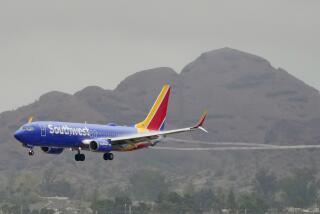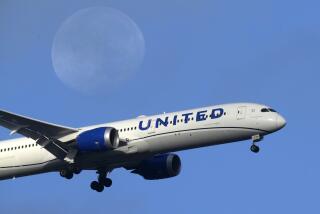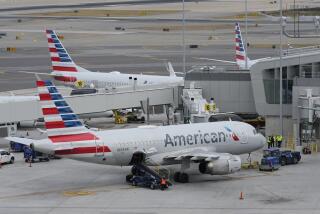Airlines to Raise Frequent Flier Mileage Minimums : Marketing: United, American and USAir are among carriers planning to up the ante for earning free flights.
New rules from some of the nation’s biggest airlines mean you’ll have to fly more miles as a paying passenger to earn minimum frequent flier awards.
Starting early next year, major airlines--led by United--will raise the number of miles to qualify for a free domestic ticket, from 20,000 to 25,000. They say it’s one way of gaining more control over a marketing device that lets so many customers fly free.
The latest notch in the seemingly never-ending belt tightening at the nation’s airlines is risky for them. They don’t want to alienate their best customers--the business fliers who pay the highest fares, fly the most frequently and have accrued enormous mileage entitling them to fat awards.
The most-frequent fliers may not necessarily see the new rules as a sacrifice, since they have so many miles accumulated anyway. But many less-frequent passengers see the awards as an entitlement. They’re angry.
“I resent it. I work hard to earn those miles,” said George Brakeley III, a fund-raising consultant for nonprofit corporations. “I regard awards from frequent flier programs as something due me, and they make it tougher and tougher and tougher to get the awards.”
For some of the most frequent fliers, the increase is actually welcome news. The higher requirement means there will be fewer people competing for free seats on the choicest routes.
“It’s gotten to be more of a seller’s market,” said Randy Mohr, who worked on developing the Diners Club frequent flier program and is now advertising manager for the National Safety Council. “There are more people with miles looking for the trips, and there are more people looking for seats.”
The vast majority of passengers, maybe 90%, are not-so-frequent fliers and have been just barely qualifying for a free ticket at the 20,000-mile level, estimated Randy Petersen, editor and publisher of InsideFlyer, a monthly magazine that provides details on frequent flier programs.
Those are the travelers, he said, who need to concentrate more on using credit cards, hotels, rental car chains and long-distance companies that are part of their frequent flier programs.
United, American and USAir are among the biggest airlines planning to increase the minimum mileage requirement for a free ticket, starting early next year.
Continental and America West are studying whether to change their programs, and Northwest is likely to raise its requirements. TWA, still recovering from years of passenger ill will encountered during its bankruptcy reorganization, has decided to leave the minimum reward level at 20,000 miles for now.
Delta is one of the few airlines that doesn’t impose a deadline on when miles can be used, but that generosity might not last.
Members of Delta’s frequent flier program say the airline has told them it is reviewing the program with an eye toward falling in line with the rest of the industry. The airline will say only that the program is under review.
Part of the reason for the industry’s increased stinginess in frequent flier awards is that you don’t have to fly to collect the miles. You can drive a rental car. You can stay in a hotel. You can charge groceries on your credit card.
Dallas-based traveling salesman Bobby Finken scored a substantial number of frequent flier miles during a two-month period late last year, but only 13% of them resulted from flying.
“The whole system has gotten so out of kilter; they pile the miles on,” said Finken, who has more than 1 million untapped miles. “I look at it like it’s money. . . . It’s there for the taking.”
But spending those miles on free trips has gotten more difficult. In recent years, airlines have limited the number of seats allotted for frequent flier freebie tickets on each flight, blacked out some of the most popular travel dates and put a three-year limit on how long the miles may remain unused.
More recently, some airlines have cut back on one of the more popular frequent flier perks--the free first-class upgrade--by reducing the number of first-class seats on their jets or eliminating first class altogether.
Airlines say the cost of the free seats has grown excessive. On a flight with 100 passengers, an average of six will be flying free on frequent flier miles. That’s a 33% increase since 1990.
Still, frequent flier programs have been a powerful selling tool for the airlines, tapping an enormous market of people who might otherwise not fly. Moreover, the programs may not be as much of a financial drain as the airlines claim.
Hotels, cellular telephone companies and the like that award frequent flier miles reimburse airlines for any free trips earned, whether the passenger cashes them or not. Not only can the airline realize a windfall from those unused mileage points, but it gets a regular check from the companies.
At the least, the airline gets free use of the money until the passenger cashes in the miles.
Then there’s the marketing value of knowing your best customers’ spending habits. The same businesses that dole out frequent flier miles covet the information and pay the airlines for their name lists as part of the deal.
From their inception as a gimmick more than a decade ago, frequent flier programs were seen as a way to instill loyalty in a business where passengers see little difference between who is providing the service.
Besides, the brains that created the programs reasoned, if the airline gives away one free ticket to Hawaii, chances are the free traveler will bring along a paying companion.
American Airlines, the first to offer a modern frequent flier program, estimated in 1981 that the perks would induce passengers to take an extra trip on American every three years, said Rolfe Shellenberger, the project manager assigned to develop American’s AAdvantage program.
As it turned out years later, the incentives were drawing frequent fliers to American an average of six additional times each year, said Shellenberger, now a travel management adviser with Runzheimer International, a consulting firm.
More to Read
Sign up for The Wild
We’ll help you find the best places to hike, bike and run, as well as the perfect silent spots for meditation and yoga.
You may occasionally receive promotional content from the Los Angeles Times.






